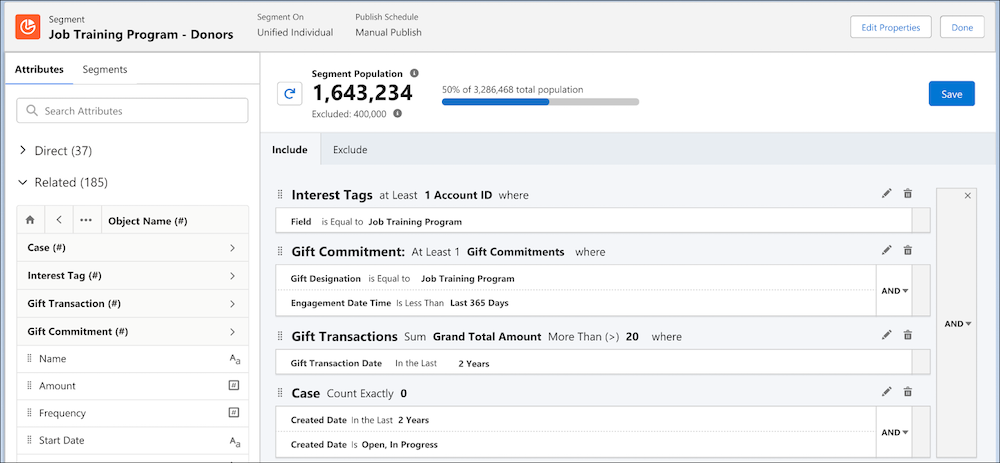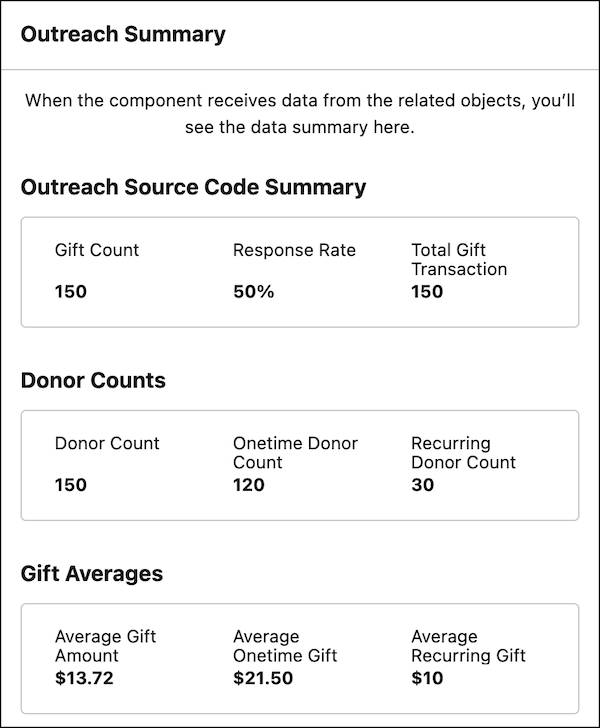Send Appeals and Track Results
Learning Objectives
After completing this unit, you’ll be able to:
- Explain how Fundraising works with segmentation in Data 360.
- Describe how Fundraising works with marketing automation systems.
- Explain campaign fields and outreach source code rollup fields and how they work.
Create a Segment
Fundraising gives you the data model to track campaigns and individual appeals. You must still create and relate a segment to those appeals and then send them, though. In this unit, you learn about tools to segment and send your appeals.
You previously learned that each outreach source code represents the intersection of a message, a channel, and an audience segment. You can create a segment in many ways. For simple segments, Fundraising includes Salesforce reports and list views. If you want more complex segments, use a tool such as Data 360 or a data lake, or work with a third-party service provider or mailing house. No matter how you segment your audience, make sure to add the total number of people in your segment to your outreach source code to calculate rollup fields like Response Rate.
Segment with Data 360
Here’s our recommended solution for complex segmentation: Data 360.

Salesforce Data 360 is a customer data platform (CDP) that collects and stores data about your stakeholders from disparate systems. This data is used to create unified stakeholder profiles and build smart audience segments. There are many other benefits to Data 360—like better data analysis—but explore segmentation for now.
Data 360 helps you to create complex segments from any information and entities in the data model. For example, Annual Giving Manager Wren uses Data 360 to create a segment of donors who:
- Live in Texas.
- Gave to HNMI’s food distribution programs in the past 5 years.
- Donated at least $1,000 to HNMI in their lifetime.
- Have a favorable Recency, Frequency, and Monetary value (RFM) score.
- Aren’t included in a major gift portfolio.
This information is spread across a donors’ gift transactions, outreach summary, person account, and other records. Data 360 easily gathers information from all of those sources and makes it actionable.
Data 360 also makes Wren’s segment dynamic, meaning the segment automatically updates as donors meet the criteria. The segment can also be linked directly to outreach source codes. When you add Data 360 to your Salesforce org, you get access to the Market Segment object to store a segment created in Data 360.
Data 360 comes with Fundraising ready to map, so your admin only has to make the connections for your data. Data 360 segments can also be linked with other marketing automation tools.
To learn more about what Data 360 can do, check out the Explore Data 360 trail. Then, talk to your Salesforce account executive about adding it to your org.
Craft and Send Your Solicitation
Crafting a great appeal is difficult. It has to grab attention and encourage stakeholders to give. Wren spends much of their time crafting and designing these messages.
Fundraising works with other systems to send the message when it’s ready. It integrates with Account Engagement, Marketing Cloud Growth, Marketing Cloud Engagement, and other marketing automation tools offered by Salesforce partners. If your organization uses Marketing Cloud Growth, you can relate an outreach source code to an email directly from the Marketing Cloud Growth flow.
Review Campaign and Outreach Source Code Progress
After Wren’s appeals go to their audiences, Wren can follow their progress with the outreach summary rollup fields that you learned about earlier in this module.

Outreach summary rollups fields update automatically with data from related records on a schedule your organization defines using flows. For example, a donor decides to give because of one of Wren’s appeals in their campaign. Wren tracks that gift in a gift transaction record created in gift entry or through an API. They then relate the gift to the appropriate campaign and outreach source code record. They can use the data from the gift transaction to calculate default rollup fields such as Gift Count and Response Rate on the campaign and outreach source code records.
What you see is an easy-to-understand rollup field, but there’s serious work happening behind the scenes. To calculate a rollup, tools called Data Pipelines and Data Processing Engine collect and transform data from fundraising records and store them in rollups fields. Those rollups fields are on the Outreach Summary object. To display the rollups on campaign and outreach source code page layouts, the Related Record Detail Display component pulls data from an outreach summary.
Talk with your admin if you want to change which rollup fields you display or create custom rollups with Data Processing Engine.
Analyze Your Data and Begin Again
In this module you learned about the tools in the Donor Engagement app that can help you conduct mass-outreach fundraising campaigns. You also learned about the mass-outreach fundraising cycle.
Wren has successfully finished their campaign. They learned which content and channels resonate with donors targeted with appeals about HNMI’s food systems development program. Through built-in rollups, Salesforce reports and dashboards, and Tableau visualizations, Wren has an idea of what can be improved in their next campaign. It’s time to go back to planning and strategy.
How could you use the Donor Engagement app on your fundraising campaigns?